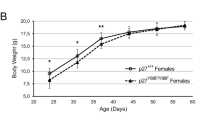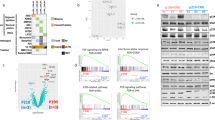Abstract
Chronic myelogenous leukemia is typically characterized by the presence of the Philadelphia chromosome (Ph) in which 5′ portions of the BCR gene are fused to a large portion of the ABL gene. Our studies and those of others indicate that Bcr sequences within the Bcr-Abl oncoprotein are critically involved in activating the Abl tyrosine kinase and actively participate in the oncogenic response, which is generated by the Bcr-Abl oncoprotein. We investigated the role of the Bcr protein in the oncogenic effects of Bcr-Abl. Reduction of the level of the Bcr protein by incubating cells with a 3′ BCR anti-sense oligodeoxynucleotide increased the growth rate and survival of hematopoietic cell lines expressing Bcr-Abl. Also, enforced expression of Bcr in Bcr-Abl cell lines strongly reduced transformation efficiency. Induction of Bcr expression drastically reduced the phosphotyrosine content of Bcr-Abl in Rat-1 fibroblasts transformed by P185 BCR-ABL and in hematopoietic cells expressing P210 Bcr-Abl within days following induction of Bcr. Rat-1/P185 cells maintained for three weeks after Bcr induction had dramatically reduced amounts of phosphotyrosine proteins compared to cells in which Bcr expression was repressed by the addition of Tet. In contrast Bcr expression did not decrease the phosphotyrosine content of either v-Src or activated Neu tyrosine kinase. Importantly, the phosphotyrosine content of total P160 BCR (induced plus endogenous) was strongly reduced by inducing expression of Bcr, indicating that the induced Bcr protein was not a target of the tyrosine kinase activity of Bcr-Abl but instead functioned as an inhibitor of Bcr-Abl. These results show that the Bcr protein can function as a negative regulator of Bcr-Abl, but that the inhibitory effects of Bcr are dependent on achieving an elevated level of Bcr expression relative to Bcr-Abl.
This is a preview of subscription content, access via your institution
Access options
Subscribe to this journal
Receive 50 print issues and online access
$259.00 per year
only $5.18 per issue
Buy this article
- Purchase on Springer Link
- Instant access to full article PDF
Prices may be subject to local taxes which are calculated during checkout






Similar content being viewed by others
References
Chuang T-H, Xu X, Kaartinen V, Heisterkamp N, Groffen J and Bokoch GM. . 1995 Proc. Natl. Acad. Sci. USA 92: 10282–10286.
Diekmann D, Brill S, Garrett MD, Totty N, Hsuan J, Monfries C, Hall C, Lim L and Hall A. . 1991 Nature 351: 400–402.
Garcia R, Parikh NU, Saya H and Gallick GE. . 1991 Oncogene 6: 1983–1989.
Hu S-X, Ji W, Zhou Y, Logothetis C and Xu H-J. . 1997 Cancer Res. 57: 3339–3343.
Hung M-C, Yan D-H and Zhao X. . 1989 Proc. Natl. Acad. Sci. USA 86: 2545–2548.
Li J and Smithgall TE. . 1996 J. Biol. Chem. 271: 32930–32936.
Liu J, Campbell M, Guo JQ, Lu D, Xian YM, Andersson BS and Arlinghaus RB. . 1993 Oncogene 8: 101–109.
Liu J, Wu Y and Arlinghaus B. . 1996a Cancer Res. 56: 5120–5124.
Liu J, Wu Y, Lu D, Haataja L, Heisterkamp N, Groffen J and Arlinghaus RB. . 1996b Mol. Cell. Biol. 16: 998–1005.
Lu D, Liu J, Campbell M, Guo JG, Heisterkamp N, Groffen J, Canaani E and Arlinghaus RB. . 1993 Blood 82: 1257–1263.
Ma G, Lu D, Wu Y, Liu J and Arlinghaus RB. . 1997 Oncogene 14: 2367–2372.
Maru Y, Peters KL, Afar DEH, Shibuya M, Witte ON and Smithgall TE. . 1995 Mol. Cell. Biol. 15: 835–842.
McWhirter JR, Galasso DL and Wang JYJ. . 1993 Mol. Cell. Biol. 13: 7587–7595.
McWhirter JR and Wang JYJ. . 1991 Mol. Cell. Biol. 11: 1553–1565.
Muller AJ, Pendergast A-M, Havlik MH, Puil L, Pawson T and Witte ON. . 1992 Mol. Cell. Biol. 12: 5087–5093.
Muller AJ, Young JC, Pendergast AM, Pondel M, Landau RN, Littman DR and Witte ON. . 1991 Mol. Cell. Biol. 11: 1785–1792.
Naumovski L, Morgan R, Hecht F, Link MP, Glader BE and Smith SD. . 1988 Cancer Res. 48: 2876–2883.
Pendergast AM, Muller AJ, Havlik MH, Maru Y and Witte ON. . 1991 Cell 66: 161–171.
Pendergast AM, Quilliam LA, Cripe LD, Bassing CH, Dai Z, Li N, Batzer A, Rabun KM, Der CJ, Schlessinger J and Gishizky M. . 1993 Cell 75: 175–183.
Puil L, Liu J, Gish G, Mbamalu G, Bowtell D, Pelicci PG, Arlinghaus R and Pawson T. . 1994 EMBO J. 13: 764–773.
Ron D, Zannini M, Lewis M, Wickner RB, Hunt LT, Graziani G, Tronick SR, Aaronson SA and Eva A. . 1991 The New Biol. 3: 372–379.
Sirard C, Laneuville P and Dick JE. . 1994 Blood 83: 1575–1585.
Varmus HE, Quintrell N and Wyke J. . 1981 Virology 108: 28–46.
Voncken JW, van Schaick H, Kaartinen V, Deemer K, Coates T, Landing B, Pattengale P, Dorseuil O, Bokoch GM, Groffen J and Heisterkamp N. . 1995 Cell 80: 719–728.
Voncken JW, Kaartinen V, Groffen J and Heisterkamp N. . 1998 Oncogene 16: 2029–2032.
Wu Y, Liu J and Arlinghaus RB. . 1998 Oncogene 16: 141–146.
Acknowledgements
RBA holds the Stringer Chair of Cancer Research. We thank Dr A Dusty Miller of the Fred Hutchison Cancer Research Center for the pLXSN for pLXSH retrovirus vectors and Dr Mikhail L Gishizky from Sugen, Inc. (Redwood, CA, USA) for Rat-1 cells. Special thanks to Gary Gallick and Mien-chie Hung's laboratories for supplying Src and Neu transformed cells, respectively, and for supplying antibodies. This work was supported by grants from the NIH (CA65611, CA49639 and CA16672).
Author information
Authors and Affiliations
Rights and permissions
About this article
Cite this article
Wu, Y., Ma, G., Lu, D. et al. Bcr: a negative regulator of the Bcr-Abl oncoprotein. Oncogene 18, 4416–4424 (1999). https://doi.org/10.1038/sj.onc.1202828
Received:
Revised:
Accepted:
Published:
Issue Date:
DOI: https://doi.org/10.1038/sj.onc.1202828
Keywords
This article is cited by
-
Kinase domain mutants of Bcr enhance Bcr-Abl oncogenic effects
Oncogene (2008)
-
Bcr is a negative regulator of the Wnt signalling pathway
EMBO reports (2005)
-
Chronic myelogenous leukemia as a paradigm of early cancer and possible curative strategies
Leukemia (2003)
-
Is there a cloud in the silver lining for imatinib?
British Journal of Cancer (2003)
-
Differential interaction and activation of Rho family GTPases by p210bcr-abl and p190bcr-abl
Oncogene (2003)



